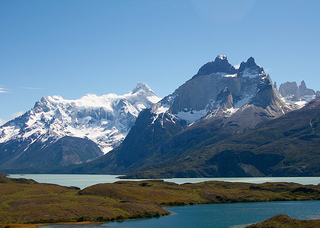
Will Thirsty Copper Mines Leave Chileans Feeling Parched?
It takes a lot of water to mine copper. This week a new report from Chile revealed that copper mining in the country’s northern region consumes the equivalent of 20 Olympic swimming pools per hour. That’s almost 3,000 gallons of water (11,203 liters) per second. And this in the middle of one of the driest deserts on Earth.
According to the Chilean Copper Commission (COCHILCO), water consumption at copper mines increased by 1 percent last year, and the agency expects the extractive industry’s thirst to grow by 24 percent by 2020. This trend is not exclusive to Chile; Peru’s National Water Authority reports that its demand for water at its mines will more than double in the same period.
Meanwhile, water is growing increasingly scarce in Chile, where copper production accounts for 20 percent of GDP. Mining companies contend that the water they consume is mostly reused, which keeps demand levels relatively low. (Chilean mines use 9 percent of the national water supply, while Peruvian mines use less than 2 percent, according to official ministry reports). They also report heavy investments in technology to improve efficiency or access. COCHILCO forecasts that by 2021 it will have invested $10 billion in seawater desalination projects, which would provide enough water to meet the current demands of the industry.
But national statistics often hide regional problems. For example, the majority of Chile’s copper mines lie in the arid north, which has access to just 7 percent of the country´s water supply. As a result, extractive processes account for as much as 70 percent of the demand in provinces like Tarapacá, Coquimbo and Atacama. In the Antofagasta province, mining operations lap up almost 80 percent of the local water supply. In Peru, mining occurs largely on the dry, western slopes of the Andes, where glaciers are receding quickly as a result of global warming.
In Chile, the debate around mining and its environmental and social impact is possible thanks to a wealth of information on water supply and use. Indeed, Chile’s Water Management Office has actively collected information to inform a national strategy on water and promote dialogue throughout the country. These debates have included international organizations such as the World Bank and the UN Economic Commission for Latin America and the Caribbean. While Peru, Mexico and Brazil collect and share similar data, they don't yet single out mining companies’ drink orders from the tab. And only Peru and Chile display information at a subnational level. The rest of South and Central America may do well to catch up.
Chile may hold a third of the world’s copper reserves, but it’s not the only natural resource in need of responsible management. Going forward, the region needs more serious discussion around public policies aimed at increasing the efficiency of and access to water consumed by mining companies, especially in light of recent challenges from global warming and the growing threat of water scarcity. The Open and reliable data that is available to all interested parties is an indispensable starting point.
Alonso Hidalgo is the information and communications assistant in the Latin America regional office of the Revenue Watch Institute – Natural Resource Charter. Claudia Viale, the organization’s Latin America research assistant, contributed to this article.

